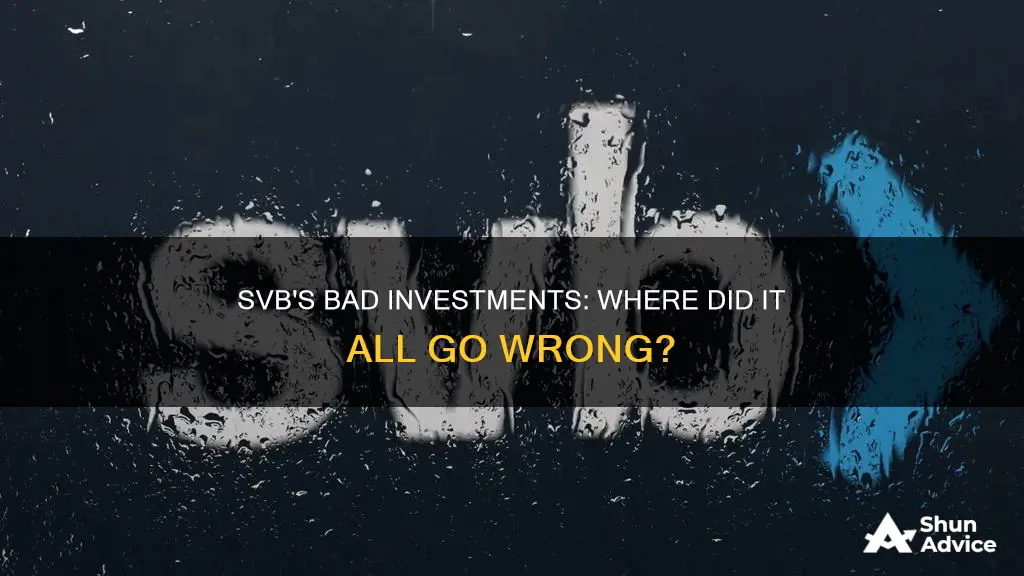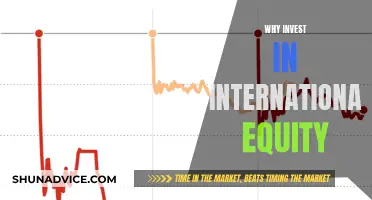
SVB Financial Group, the parent company of Silicon Valley Bank, has made several bad investments that have led to its decline. The bank received a large volume of deposits during the 2020-2021 tech boom and invested the proceeds in long-term Treasury bonds when interest rates were low. As interest rates rose, the market value of these Treasuries decreased, resulting in a loss for SVB. The bank also faced high cash burn rates from clients and rapid deposit outflows, which further contributed to its financial troubles. SVB's decision to invest heavily in low-interest mortgage securities and its inability to loan capital effectively also played a role in its downfall.
| Characteristics | Values |
|---|---|
| SVB Financial Group's bad investments | Sold $21 billion worth of available-for-sale securities at a $1.8 billion loss |
| Invested in long-term Treasury bonds while interest rates were low, and then rates rose | |
| Clients' cash burn rates didn't slow down as anticipated | |
| Deposits left the bank faster than expected | |
| Too many assets were tied up in long-dated Treasuries | |
| Unprepared for the effects of massive outflows in the difficult venture capital environment |
What You'll Learn

SVB sold $21 billion in assets for a $1.8 billion loss
SVB Financial Group (SIVB.Q), the parent company of Silicon Valley Bank, has been facing significant challenges that have impacted its financial standing. One of the key issues that led to its troubles was the sale of a substantial portion of its assets, amounting to a loss of $1.8 billion. Specifically, SVB offloaded $21 billion worth of available-for-sale securities, primarily consisting of U.S. Treasury securities. This move was driven by the need to address the challenges arising from the changing economic landscape.
During the 2020-2021 tech boom, SVB received a large influx of deposits as a result of the favourable conditions for venture capital. With interest rates at low levels, the bank invested these deposits into long-term Treasury bonds. However, as interest rates started to rise, the market value of these Treasuries decreased significantly. This meant that the value of SVB's investments had substantially declined compared to what they had paid for them.
Facing losses and the challenge of excessive deposit outflows, SVB was forced to take action. The bank decided to sell its available-for-sale securities to cut its losses and reinvest the capital into higher-yielding assets, anticipating an improvement in their net interest income. Unfortunately, this decision had unintended consequences. The market interpreted this move as a sign of distress, leading to a loss of confidence in the bank's health and stability.
The situation was further exacerbated by the high cash burn rates of SVB's clients, which continued to be elevated even as the venture capital environment became more difficult. This meant that deposits were leaving the bank faster than expected, creating a strain on SVB's liquidity. As a result, SVB found itself in a challenging position, struggling to raise the necessary capital and ultimately leading to its decision to put itself up for sale.
The case of SVB highlights the delicate balance between managing investments and depositor confidence in the volatile world of finance. It serves as a reminder that financial institutions must carefully navigate their investment strategies while maintaining the trust of their customers to avoid triggering panic and ensuring their long-term viability.
Wealth Managers: Where Do They Invest Your Money?
You may want to see also

Clients' cash burn rates didn't slow as expected
SVB Financial Group, the parent company of Silicon Valley Bank, has been facing a challenging situation due to various factors, including high client cash burn rates. The bank has experienced a significant decline in its shares, with a 60% plunge on Thursday followed by another 60% drop in premarket activity on Friday. This led to regulators stepping in to shut down the bank.
One of the critical issues contributing to SVB's troubles is the high client cash burn rates. Despite the current economic climate, the bank noted that clients' cash burn rates had not slowed down as expected. This meant that deposits were leaving the bank at a faster rate than anticipated. SVB attributed this to clients investing heavily in their businesses, which resulted in elevated cash burn levels.
The high client cash burn rates had a significant impact on SVB's financial position. The bank had to sell its available-for-sale securities, amounting to $21 billion, at a substantial loss of $1.8 billion. This loss was primarily driven by the sale of U.S. Treasury securities, which had decreased in market value due to rising interest rates.
SVB's decision to sell its AFS portfolio was intended to address the squeeze on its net interest margin (NIM). With banking customers expecting competitive yields on their deposits, the bank found itself holding low-yielding assets while paying out higher interest on deposits. By selling the AFS portfolio, SVB expected to boost its annualized net interest income (NII) by an estimated $450 million.
However, the announcement of the AFS portfolio sale, along with share sales and an increase in term borrowing, sparked concern in the venture and startup markets. This concern escalated to fear and panic, leading to a bank run as customers rushed to withdraw their deposits. The outflow of deposits further exacerbated SVB's financial troubles, ultimately leading to the bank's decision to put itself up for sale.
In summary, SVB Financial Group's challenges were partly due to client cash burn rates that did not slow down as expected. This, coupled with other factors such as the sale of low-yielding assets and the impact of rising interest rates, contributed to the bank's financial woes and eventual decision to seek a sale.
Invest in Franklin India Prima Plus: A Guide
You may want to see also

SVB tied too much of its assets to long-term treasuries
SVB Financial Group, the parent company of Silicon Valley Bank, has made some questionable investments that have led to significant losses and a decline in its stock price. One of the main issues was its decision to tie a large portion of its assets to long-term treasury bonds. During the 2020-2021 tech boom, SVB received a substantial volume of deposits and chose to invest the proceeds in long-term Treasury bonds when interest rates were low.
However, as interest rates rose, the market value of those Treasuries decreased substantially. SVB sold $21 billion worth of available-for-sale securities, primarily U.S. Treasury securities, at a loss of $1.8 billion. The increase in interest rates also affected the bank's clients, who continued to experience high cash burn rates, contrary to expectations of a slowdown. This resulted in faster-than-anticipated deposit outflows from the bank.
SVB's decision to invest heavily in long-term Treasuries while failing to anticipate the impact of high cash burn rates and deposit outflows in a challenging venture capital environment contributed to its financial troubles. The bank's inability to adapt to changing market conditions and diversify its investments led to significant losses and a decline in market confidence.
The bank's financial woes were further exacerbated by the decline in the value of low-yield assets as interest rates rose. This squeezed their net interest margin as they were holding low-yielding assets while paying higher interest rates on deposits. In an attempt to mitigate these issues, SVB decided to sell its available-for-sale portfolio at a loss and reinvest in higher-yielding assets. However, this move caused concern among investors, leading to a panic that resulted in a rapid outflow of deposits and further deteriorating the bank's financial health.
In summary, SVB's decision to tie a significant portion of its assets to long-term treasuries during a period of low-interest rates proved to be a bad investment choice when interest rates rose. This, coupled with other factors, led to a perfect storm of financial challenges for the bank.
Opening an Investment Advisory Firm: Navigating India's Market
You may want to see also

SVB was unprepared for the effects of massive outflows
SVB Financial Group, the parent company of Silicon Valley Bank, has made some bad investments, leading to a turbulent period and significant losses. One of its major issues was its investment strategy during the 2020-2021 tech boom. During this period, SVB received a large volume of deposits due to the influx of capital into the tech industry. However, instead of diversifying its investments, SVB tied up too much of its assets in long-term Treasury bonds while interest rates were low.
As a result, when interest rates rose, the market value of those Treasury bonds decreased substantially. SVB was forced to sell these investments at a loss, further exacerbating the situation. This decision to sell its available-for-sale securities at a loss was driven by the expectation of continued higher interest rates and elevated cash burn levels from clients.
The bank also faced challenges due to the rapid outflow of deposits. SVB was unprepared for the massive outflows as deposits left the bank faster than anticipated in the current economic climate. This was partially due to the advice of several notable venture capital funds, which recommended their portfolio companies move their funds out of SVB to avoid the potential loss of access to their money in the event of a bank failure. As a result, SVB faced a crisis of confidence, with customers losing trust in the bank's health and stability.
The combination of poor investment decisions and massive outflows of deposits led to a perfect storm for SVB, resulting in significant losses, a plunge in its stock price, and ultimately, its closure by regulators. The situation highlights the delicate balance between investment strategies and deposit management in the banking industry, especially when dealing with volatile market conditions.
Smart Ways to Invest 3 Lakhs in India
You may want to see also

SVB's decision to invest in low-interest mortgage securities
SVB Financial Group, the parent company of Silicon Valley Bank, has recently encountered significant challenges, with its shares plummeting by over 60% following the announcement of its need to raise capital. This crisis has led to regulators shutting down the bank. So, what led to this downfall?
One key factor was SVB's decision to invest heavily in low-interest mortgage securities, primarily long-term U.S. Treasury bonds. During the 2020-2021 tech boom, SVB received a substantial volume of deposits, which it invested in these long-term, low-interest securities while interest rates were low. However, as interest rates rose, the market value of these Treasuries decreased substantially, resulting in significant losses for the bank. SVB sold $21 billion worth of available-for-sale securities, incurring a loss of $1.8 billion, mainly due to the decline in the value of U.S. Treasury securities.
The bank's decision to focus on low-interest mortgage securities proved unwise, especially when interest rates increased. This resulted in a squeeze on its net interest margin (NIM) as SVB was holding low-yielding assets while paying out higher interest on deposits. The rise in interest rates, coupled with the decline in venture capital investment, led to a fall in the value of low-yield assets, further exacerbating the problem.
To address this issue, SVB decided to sell its available-for-sale (AFS) portfolio at a loss and reinvest the capital into higher-yielding assets, anticipating an increase in net interest income (NII). However, this move caused concern among investors, leading to a panic that resulted in a rapid outflow of deposits and contributing to the bank's downfall.
In summary, SVB's decision to invest heavily in low-interest mortgage securities during a period of low-interest rates backfired when interest rates rose, causing a decline in the value of their assets and creating a challenging situation for the bank. This, along with other factors, contributed to the crisis that ultimately led to the closure of Silicon Valley Bank.
Smart Ways to Invest 70 Lakhs in India
You may want to see also
Frequently asked questions
SVB Financial Group, the parent company of Silicon Valley Bank, sold $21 billion worth of available-for-sale securities at a loss of $1.8 billion. The bank had invested in long-term Treasury bonds when interest rates were low during the 2020-2021 tech boom. As interest rates rose, the market value of those Treasuries decreased substantially.
SVB's shares fell by more than 60% after it was revealed that the bank needed to raise capital. Trading was halted following another 60% plunge in premarket activity, and the bank was eventually shut down by regulators.
High startup burn rates and an outflow of deposits from the bank also contributed to SVB's troubles. Clients' cash burn rates had not slowed down as expected, and deposits were leaving the bank faster than anticipated.
SVB announced a plan to raise over $2 billion in capital through stock sales and borrowing. The bank also intended to sell itself after these efforts failed to stabilize its financial position.







